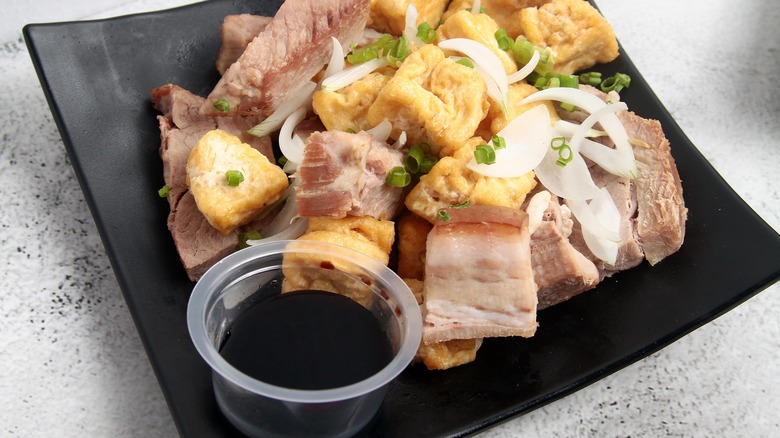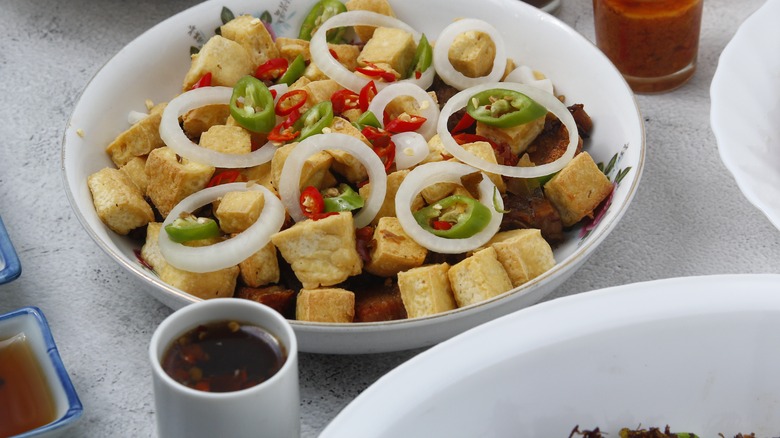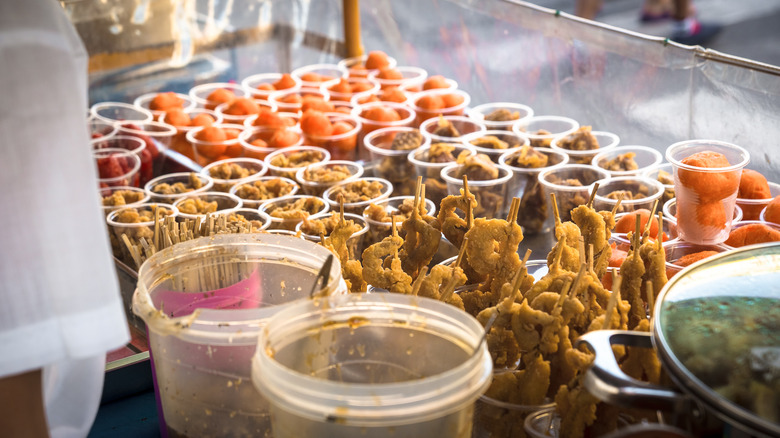The Filipino Vinegar-Based Dipping Sauce You Need To Know About
Sawsawan is the generic Tagalog word for a group of spicy Filipino condiments used for dipping grilled and fried meats. Toyomansi features soy sauce and Philippine lime; patis centers fish sauce; and red chilies are present in all of them. Sawsawan dipping sauces are generally mixed together by the patrons themselves at market stall food vendors. One of the most popular Filipino dips is made with spicy vinegar. Sukang sawsawan is bright, beguiling, and fiercely hot — in other words, the perfect dip. It's high time to get to know this particular aspect of Filipino cuisine.
Over the centuries, Filipinos have become vinegar connoisseurs because of what they call asim; its sour, flavor-enhancing property. In the pre-colonial era, vinegar was used as a preservative until ultimately took the main stage either as a featured ingredient in marinades, braises, and chicken adobo or as a beloved, ubiquitous condiment. Because of this, Filipinos use a diverse number of kinds of vinegar with different strengths, sweetness, and flavor profiles depending on their application: Sukang paombong is decidedly sour and perfect for pickling papaya. Sukang tuba is fermented coconut tree sap, often combined with fresh fish to make the Filipino version of ceviche.
How to make Sukang sawsawan
Traditionally, the sweet vinegar most often used for making sukang sawsawan is sukang maasim, or fermented cane sugar sap. Its comparatively mild flavor makes it ideal for dipping. Because of this, it's best if you can find sugarcane vinegar, as it will be the star of the show. Coconut vinegar will also do just fine. Combine vinegar, minced ginger, sliced garlic, thinly-sliced shallot or red onion, and several bird's eye chilies in a clean mason jar. If you're into it, adding a minced habanero pepper will provide not only purifying heat but a lovely background fruitiness. Stir in dried fruit or sugar for sweetness, along with salt or fish sauce and black peppercorns.
Sukang sawsawan is as varied as the individuals who make it. This general recipe is only intended to get you started on the road to creating your own favorite Filipino dipping sauce. Your sawsawan will taste best if given three days in the refrigerator for the flavors to come together. Not only will it keep indefinitely, but the flavors will also continue to combine and deepen as the dipping sauce ages.
Sawsawan, the exemplar of Filipino culture
Sawsawan is more than just the name for a collection of bespoke dipping sauces — it's a way of life. Sawsawan culture removes the distinction between the cook and the consumer because each sauce is made by the diner to tailor the dish to their individual taste. Sawsawan exemplifies the communal nature of Filipino cuisine by embodying inclusiveness and hospitality.
This is a far cry from the custom of public food consumption in the West, where diners, at most, might have the option of adding salt and pepper to their food, and some hot sauce if they're lucky. Western chefs are often insulted by patrons seasoning their creations, thereby enforcing a kind of top-down food hierarchy. The consumption of street food — made to be eaten by hand — is another matter entirely, and with sawsawan, Filipinos have evolved an entire ethos of communal food consumption which also caters to individual taste. That's a pretty amazing outcome from mashing together sweet vinegar, hot chilies, and aromatics in a little dish.


